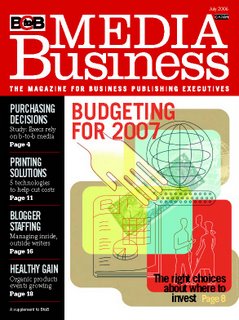Publishing: 5 Printing Technologies to Watch
 The July issue of Media Business is available for download at b2bonline.com. The latest issue carries a list of five printing solutions that promise to boost efficiency and cuts publishing costs. They are:
The July issue of Media Business is available for download at b2bonline.com. The latest issue carries a list of five printing solutions that promise to boost efficiency and cuts publishing costs. They are:1.JDF: Job definition format (JDF) provides a common, dedicated language for use throughout the lifecycle of the print job and a method for automated work flows in print production. Changing to JDF will eliminate the need for publishers to send heavily marked-up proofs to printers since everything will be noted digitally.
2. Softproofing: Softproofing, or viewing pages on a computer rather than as a hard copy, is another technology that promises to help automate work flows. But while many printers and publishers already do this, there isn’t yet a fully standardized set of color numbers for the industry to follow. Softproofing is expected to eliminate problems and costs associated with hardproofing and cut down on time dealing with printers and ad agencies.
3. Co-mailing: Several printing companies have recently opened sophisticated co-mailing facilities. Quebecor is working to add polybagging to its co-mailing services, having already solved the puzzle of how to co-mail titles with advertising belly bands. RR Donnelley is focused on its co-mailing tracking and tracing capabilities, which allow publishers to see delivery confirmation by postal destination, the total number of pieces in a shipment and the date.
4. Digital Editions: Publishers Press, magazine printing specialist, is one of many printers getting into the digital-editions business. Fry Communications is cranking out 30,000 pages of electronic editions each month and has focused on getting content quickly up onto publisher Web sites with multimedia attached.
5. Personalization: As more information about readers gets digitized, personalization is becoming easier for publishers. Fry Communications recently installed a perfect binder that can selectively polybag titles with up to five outserts. It can also print a personalized message on the outside of the polybag.
Download the entire issue of Media Business or read the article here.
Labels: Publishing



0 Comments:
Post a Comment
<< Home